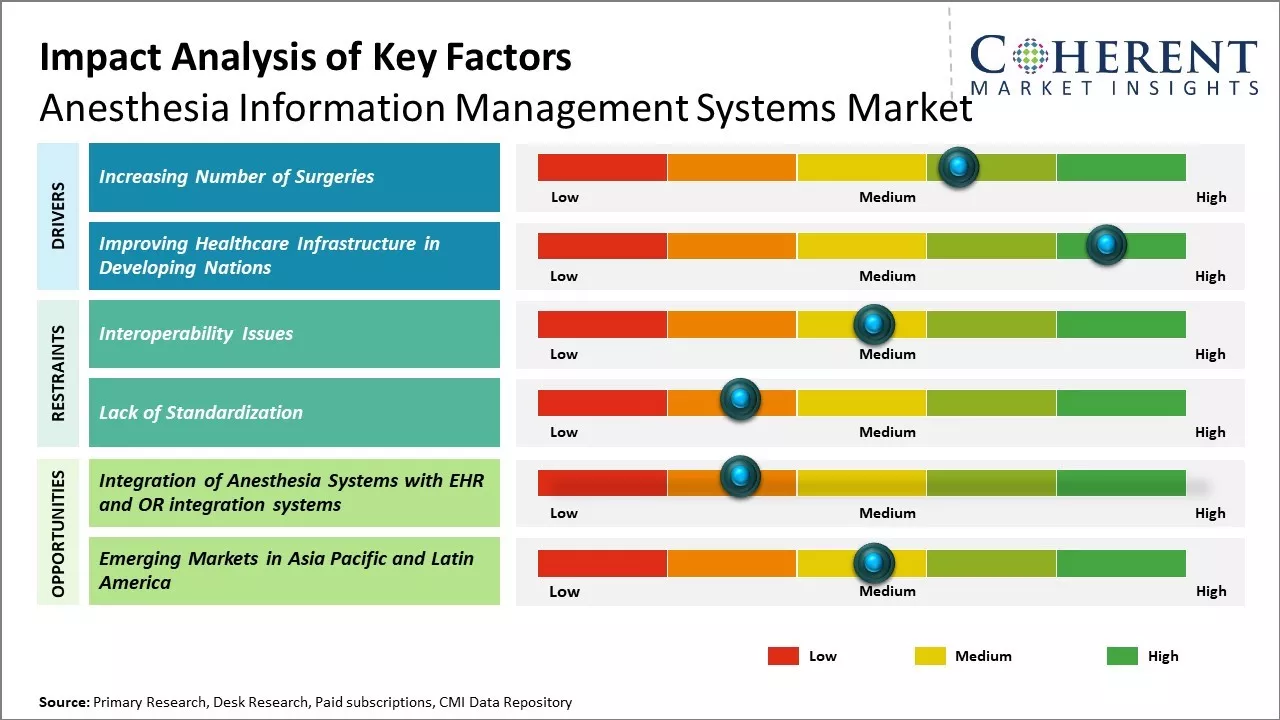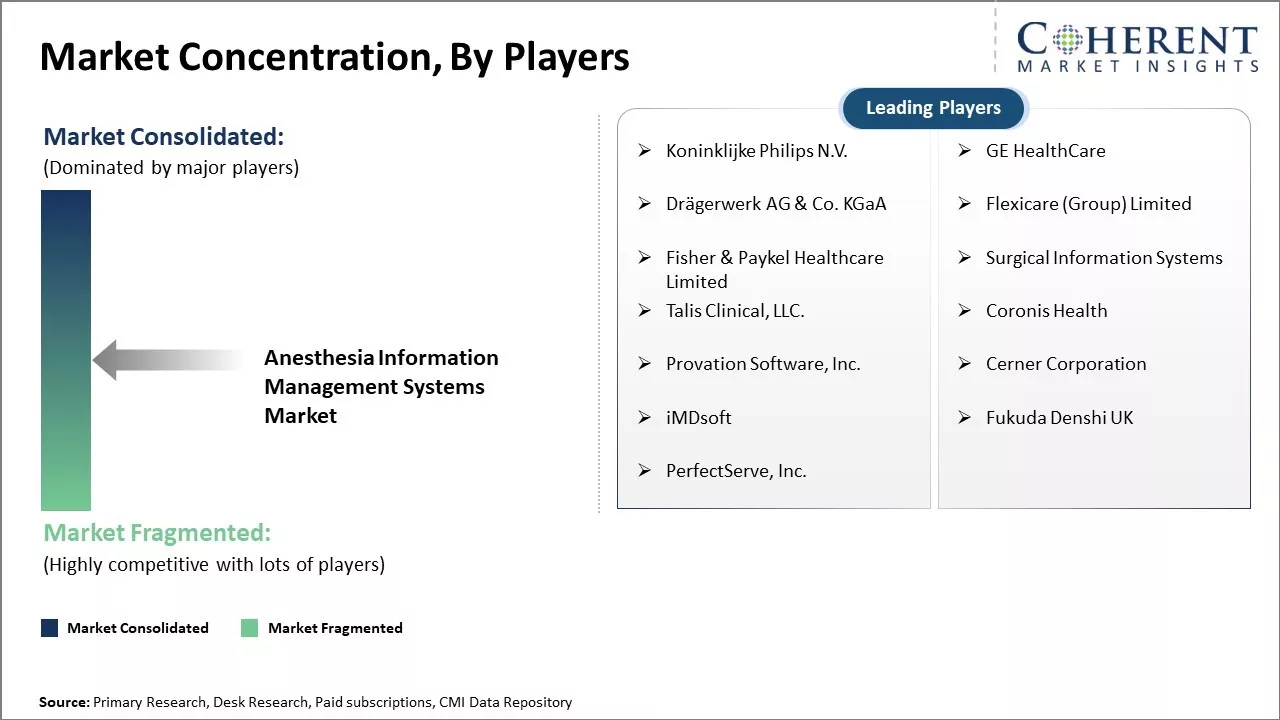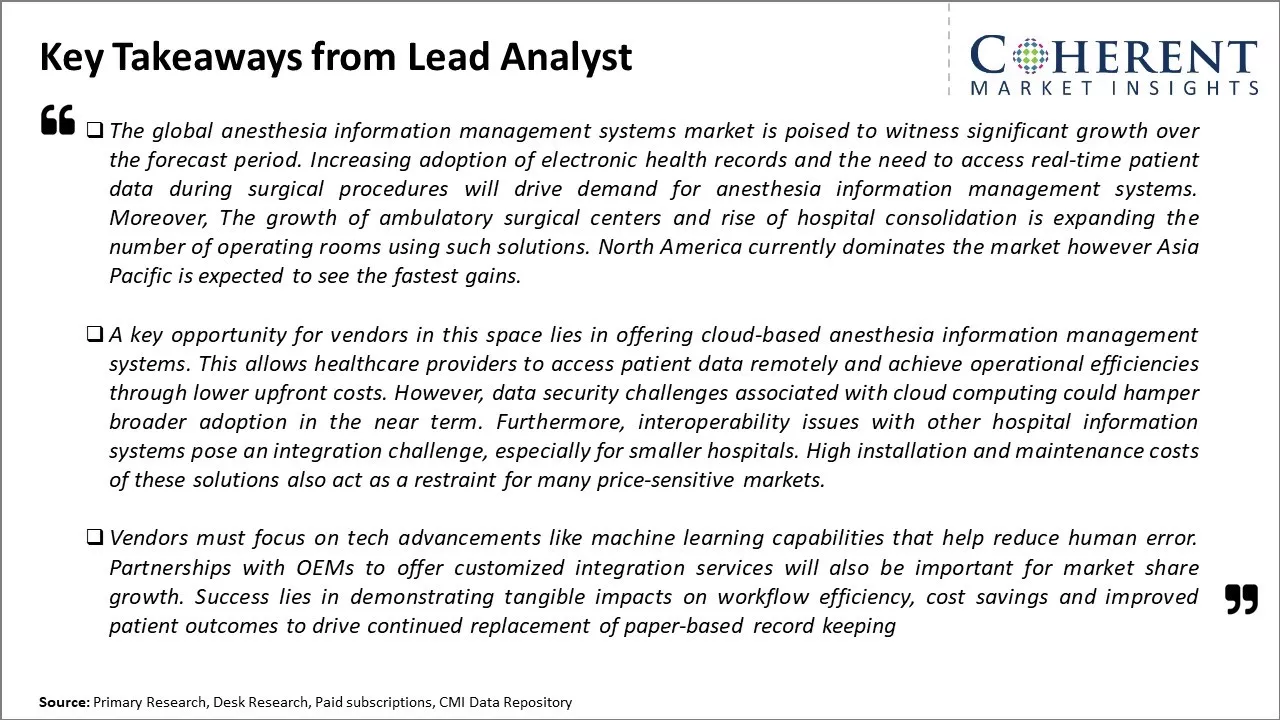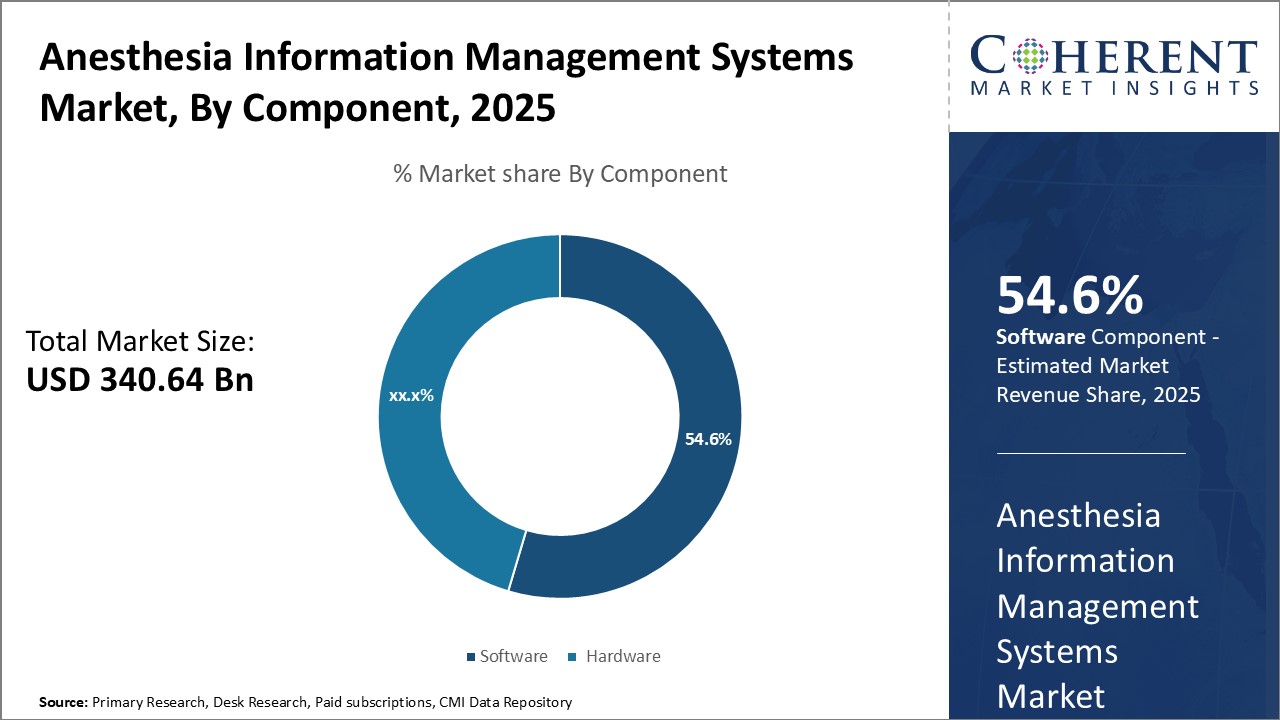Anesthesia Information Management Systems Market Size and Trends
The global anesthesia information management systems market is estimated to be valued at USD 340.64 Bn in 2025 and is expected to reach USD 512.54 Bn by 2032, exhibiting a compound annual growth rate (CAGR) of 6.0% from 2025 to 2032.

Discover market dynamics shaping the industry: Download Free Sample
Anesthesia information management systems help eliminate manual documentation errors, streamline workflows, and facilitate compliance. They allow the easy integration of anesthesia device outputs into the electronic medical record to track medications, vitals, procedures, and enhance patient safety. Rising need to reduce healthcare costs, move to digital technologies, and growing preference for digital record keeping are expected to drive the anesthesia information management systems market during the forecast period. Implementation of stringent regulations regarding use of electronic health records, increasing volume of surgeries performed, and higher adoption rate among hospitals and ambulatory surgical centers are also anticipated to support this growth. However, high costs of installation, maintenance of these systems along with lack of knowledge among hospitals in developing countries may restrain market expansion.
Increasing Number of Surgeries
With the rapid growth in the global population and changes in lifestyle leading to various health issues, the number of surgical procedures performed worldwide has risen over the past few decades. Anesthesia plays a vital role in all modern surgical practices. As the surgical volume increases across medical facilities, there is growing need for advanced anesthesia information management systems that can help monitor and record important anesthesia-related data digitally during surgical procedures. These systems ensure patient safety and aid anesthesiologists in delivering the highest quality of care. They minimize errors, streamline workflow in the operating room, and allow storing of anesthesia records electronically for future reference and clinical research. With worldwide healthcare expenditures rising continuously, hospitals and ambulatory surgical centers are increasingly adopting AIMS to gain efficiencies, cut costs and meet regulatory compliance. The growing surgical caseload puts pressure on existing resources which is another key factor driving hospitals to implement digital anesthesia management solutions.
Market Concentration and Competitive Landscape

Get actionable strategies to beat competition: Download Free Sample
Improving Healthcare Infrastructure in Developing NationsImproving healthcare infrastructure in developing nations is a key driver behind the growth of the global anesthesia information management systems market. Governments in developing countries are increasingly focusing on expanding access to advanced healthcare facilities to serve their rapidly growing populations. This includes establishing new hospitals as well as upgrading existing infrastructure with state-of-the-art medical technologies and digitization. Anesthesia information management systems provide digital support for anesthesia delivery work processes, helping enhance patient safety, optimize resource utilization, and improve outcomes. Their role in automating record-keeping, tracking drug consumption, and generating analytics has helped boost efficiency and quality of care in developed world healthcare systems. As developing nations look to modernize their medical infrastructure on these lines, adoption of anesthesia information management solutions is on the rise. Systems offer valuable insights into perioperative processes and performance that helps nationwide healthcare programs.

To learn more about this report, Download Free Sample
Market Challenges – Interoperability IssuesInteroperability issues pose a significant challenge for the growth of the global anesthesia information management systems market. When different medical devices and software applications are unable to seamlessly exchange and integrate information, it hampers the overall workflow and efficiency within the operating rooms. This leads to delays, manual errors, and increased cost of maintaining unintegrated systems and poor patient outcome.
Market Opportunities – Expanding Applications in Developing Countries
Integration of anesthesia information management systems (AIMS) with electronic health records (EHR) and operating room integration systems holds huge potential for the global anesthesia information management systems market. With healthcare undergoing rapid digitization worldwide, integrating AIMS with other hospital IT systems can deliver improved clinical workflows and patient outcomes. A fully integrated system allows seamless sharing of anesthesia data between the operating room and other parts of the hospital. This gives clinicians a complete picture of the patient's medical history and treatment. Anesthesia records and monitoring data becomes part of the patient's EHR, enhancing clinical documentation and postoperative care. Integration with operating room systems helps automate scheduling, inventory and billing processes. With multiple systems interacting as a cohesive whole, hospitals can leverage data to enhance efficiency, reduce errors and costs.

Discover high revenue pocket segments and roadmap to it: Download Free Sample
Insights, By Component: Increasing Demand For Integrated Software SolutionsThe component segment includes software and hardware. The software sub-segment is estimated to hold 54.6% of the market share in 2025 owing to the growing demand for advanced data analytics capabilities from healthcare providers. Software solutions allow for easy integration of anesthesiology documentation and patient health records with other hospital information systems. This facilitates streamlined clinical workflow and comprehensive data visibility across departments. Software products are being incorporated with machine learning and artificial intelligence functionalities. This enables automated reporting, real-time monitoring, and predictive analytics based on past clinical data and outcomes. Such analytical insights help identify high-risk patients, improve resource utilization, and reduce surgical complications. Leading vendors are focusing on developing sophisticated software suites that can analyze vast amounts of structured and unstructured data to provide actionable clinical decision support to anesthesiologists and operating room staff. Rising adoption of electronic health records has also fueled the need for interoperable anesthesia software solutions. This ensures continuity of care and relevant perioperative data is seamlessly shared among surgeons, nursing teams and post-operative units. Advanced software capabilities along with flexibility of regular remote updates and upgrades are some key factors driving providers to prefer vendor-hosted cloud-based platforms over on-premise models. This burgeoning demand for analytics-enabled software with superior integration capabilities has made it the largest segment in the anesthesia information management systems market.
Insights, By Application: Intraoperative Mode Dominates Due to Real Time Monitoring Needs
The application segment includes intraoperative mode and preoperative mode. The intraoperative mode sub-segment is estimated to hold 52.3% of the market share in 2025 owing to hospitals' need for real time patient monitoring during surgeries. The intraoperative mode allows anesthesia providers to view patient parameters, drug administration records, and other operation details right on the screens placed in the operation theatre. This helps them closely monitor patient's anesthesia response and make necessary adjustments during ongoing surgeries. Any delays or lapses in real time monitoring could prove risky for patients' lives. Therefore, most healthcare facilities prefer intraoperative anesthesia information management systems to ensure utmost safety during surgical procedures. This drives the highest demand for intraoperative applications compared to other segments like preoperative mode.
Insights, By End User: Hospitals Lead Due to High Patient Volume and Complex Surgeries
The end user segment includes hospitals, clinics, ambulatory surgery centers, and others. The hospitals sub-segment is estimated to hold 43% of the market share in 2025 due to their high patient influx and complexity of surgeries. Hospitals cater to a massive patient volume on a daily basis and conduct diverse types of surgeries from simple ones to highly complicated cases. This puts a lot of pressure on anesthesia providers to thoroughly document details of every patient and surgery. Anesthesia information management systems help hospitals seamlessly manage massive records and data of thousands of patients handled every year. The complex nature of surgeries in hospitals also necessitates close monitoring using these systems. Ambulatory centers and clinics have comparatively fewer patients and basic surgeries. Therefore, their demand for advanced AIMS is relatively lower than hospitals. This attributes to hospitals dominating the end user segment.
Regional Insights

Need a Different Region or Segment? Download Free Sample
North America remains the dominant region in the global anesthesia information management systems market and is estimated to hold 36.1% of the market share in 2025. The large size and maturity of the healthcare sector in countries such as the U.S. has led to the widespread adoption of digital record-keeping solutions across hospitals and ambulatory surgical centers. High awareness among medical practitioners about the benefits of automated record management systems for enhancing workflow efficiency and patient safety has propelled North America's leadership. Stringent regulatory mandates regarding compliance with data protection norms have further encouraged healthcare providers in the region to integrate advanced IT systems. Several leading international players have also established their headquarters in the U.S., giving North American hospitals early access to innovative offerings. Moreover, the high purchasing power of consumers has allowed healthcare institutions to make significant investments in upgrading their operating room technologies.
Asia Pacific has emerged as the fastest growing regional market. Countries such as China, India, and Southeast Asian nations have witnessed exponentially rising medical expenditures and a rapidly expanding middle-class population in recent times. This has heightened the focus on revamping outdated healthcare infrastructures and improving service quality. Along with it, there is a growing focus among governments to promote digitization across the healthcare sector. This has opened up massive opportunities for providers of cutting-edge medical technologies in the region. With their relatively untapped potentials, many APAC countries still lag behind in terms of anesthesia management practices. Vendors are actively educating doctors and carrying out demonstrations to boost adoption. The strengthening economic scenario is enabling leading private and public hospitals to incorporate advanced IT-enabled anesthesia record systems as part of their technology upgrades. Foreign OEMs are also exploring partnerships with local players to establish manufacturing and distribution networks.
Market Report Scope
Anesthesia Information Management Systems Market Report Coverage
| Report Coverage | Details | ||
|---|---|---|---|
| Base Year: | 2024 | Market Size in 2025: | USD 340.64 Bn |
| Historical Data for: | 2020 To 2024 | Forecast Period: | 2025 To 2032 |
| Forecast Period 2025 to 2032 CAGR: | 6.0% | 2032 Value Projection: | USD 512.54 Bn |
| Geographies covered: |
|
||
| Segments covered: |
|
||
| Companies covered: |
Koninklijke Philips N.V., GE HealthCare, Drägerwerk AG & Co. KGaA, Flexicare (Group) Limited, Fisher & Paykel Healthcare Limited, Surgical Information Systems, Talis Clinical, LLC., Coronis Health, Provation Software, Inc., Cerner Corporation, iMDsoft, Fukuda Denshi UK, and PerfectServe, Inc. |
||
| Growth Drivers: |
|
||
| Restraints & Challenges: |
|
||
Uncover macros and micros vetted on 75+ parameters: Get instant access to report
Anesthesia Information Management Systems Industry News
- In April 2022, AnesthesiaGo, a first-of-its-kind solution for automatically generating daily case assignments for anesthesia staff, was acquired by PerfectServe, Inc., a software company. This acquisition will assist the company to strengthen its position as the industry pioneer in cutting-edge scheduling technology.
- In February 2022, Coronis Health (Plexus Technology Group, LLC), a software company, proclaimed that its Anesthesia Touch has grabbed a critical breakthrough by being deployed into over 1,000 hospital systems countrywide
*Definition: Anesthesia Information Management Systems (AIMS) are electronic systems that collect and manage data related to anesthesia care including steps in procedures, drug administrations, and measurements. AIMS can reduce the anesthesiologist's workload and provide decision support to improve safety and efficiency in the operating room.
Market Segmentation
- Component Insights (Revenue, USD Bn, 2020 - 2032)
- Software
- Hardware
- Application Insights (Revenue, USD Bn, 2020 - 2032)
- Intraoperative Mode
- Preoperative Mode
- End User Insights (Revenue, USD Bn, 2020 - 2032)
- Hospitals
- Clinics
- Ambulatory Surgery Centers
- Others
- Regional Insights (Revenue, USD Bn, 2020 - 2032)
- North America
- U.S.
- Canada
- Latin America
- Brazil
- Argentina
- Mexico
- Rest of Latin America
- Europe
- Germany
- U.K.
- Spain
- France
- Italy
- Russia
- Rest of Europe
- Asia Pacific
- China
- India
- Japan
- Australia
- South Korea
- ASEAN
- Rest of Asia Pacific
- Middle East
- GCC Countries
- Israel
- Rest of Middle East
- Africa
- South Africa
- North Africa
- Central Africa
- North America
- Key Players Insights
- Koninklijke Philips N.V.
- GE HealthCare
- Drägerwerk AG & Co. KGaA
- Flexicare (Group) Limited
- Fisher & Paykel Healthcare Limited
- Surgical Information Systems
- Talis Clinical, LLC.
- Coronis Health
- Provation Software, Inc.
- Cerner Corporation
- iMDsoft
- Fukuda Denshi UK
- PerfectServe, Inc.
Share
Share
About Author
Komal Dighe is a Management Consultant with over 8 years of experience in market research and consulting. She excels in managing and delivering high-quality insights and solutions in Health-tech Consulting reports. Her expertise encompasses conducting both primary and secondary research, effectively addressing client requirements, and excelling in market estimation and forecast. Her comprehensive approach ensures that clients receive thorough and accurate analyses, enabling them to make informed decisions and capitalize on market opportunities.
Missing comfort of reading report in your local language? Find your preferred language :
Transform your Strategy with Exclusive Trending Reports :
Frequently Asked Questions
EXISTING CLIENTELE
Joining thousands of companies around the world committed to making the Excellent Business Solutions.
View All Our Clients
